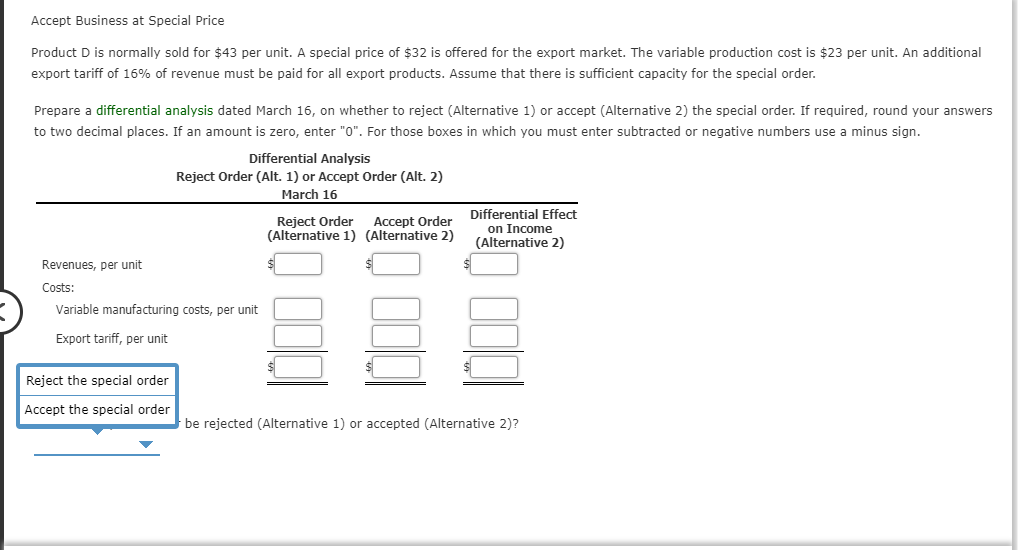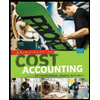Accept Business at Special Price Product D is normally sold for $43 per unit. A special price of $32 is offered for the export market. The variable production cost is $23 per unit. An additional export tariff of 16% of revenue must be paid for all export products. Assume that there is sufficient capacity for the special order. Prepare a differential analysis dated March 16, on whether to reject (Alternative 1) or accept (Alternative 2) the special order. If required, round your answers to two decimal places. If an amount is zero, enter "0". For those boxes in which you must enter subtracted or negative numbers use a minus sign. Differential Analysis Reject Order (Alt. 1) or Accept Order (Alt. 2) March 16 Differential Effect on Income (Alternative 2) Reject Order (Alternative 1) (Alternative 2) Accept Order Revenues, per unit Costs: Variable manufacturing costs, per unit Export tariff, per unit Reject the special order Accept the special order be rejected (Alternative 1) or accepted (Alternative 2)?
Accept Business at Special Price Product D is normally sold for $43 per unit. A special price of $32 is offered for the export market. The variable production cost is $23 per unit. An additional export tariff of 16% of revenue must be paid for all export products. Assume that there is sufficient capacity for the special order. Prepare a differential analysis dated March 16, on whether to reject (Alternative 1) or accept (Alternative 2) the special order. If required, round your answers to two decimal places. If an amount is zero, enter "0". For those boxes in which you must enter subtracted or negative numbers use a minus sign. Differential Analysis Reject Order (Alt. 1) or Accept Order (Alt. 2) March 16 Differential Effect on Income (Alternative 2) Reject Order (Alternative 1) (Alternative 2) Accept Order Revenues, per unit Costs: Variable manufacturing costs, per unit Export tariff, per unit Reject the special order Accept the special order be rejected (Alternative 1) or accepted (Alternative 2)?
Managerial Accounting
15th Edition
ISBN:9781337912020
Author:Carl Warren, Ph.d. Cma William B. Tayler
Publisher:Carl Warren, Ph.d. Cma William B. Tayler
Chapter11: Differential Analysis And Product Pricing
Section: Chapter Questions
Problem 6BE
Related questions
Question
100%

Transcribed Image Text:Accept Business at Special Price
Product D is normally sold for $43 per unit. A special price of $32 is offered for the export market. The variable production cost is $23 per unit. An additional
export tariff of 16% of revenue must be paid for all export products. Assume that there is sufficient capacity for the special order.
Prepare a differential analysis dated March 16, on whether to reject (Alternative 1) or accept (Alternative 2) the special order. If required, round your answers
to two decimal places. If an amount is zero, enter "0". For those boxes in which you must enter subtracted or negative numbers use a minus sign.
Differential Analysis
Reject Order (Alt. 1) or Accept Order (Alt. 2)
March 16
Differential Effect
on Income
(Alternative 2)
Reject Order
(Alternative 1) (Alternative 2)
Accept Order
Revenues, per unit
Costs:
Variable manufacturing costs, per unit
Export tariff, per unit
Reject the special order
Accept the special order
be rejected (Alternative 1) or accepted (Alternative 2)?
Expert Solution
This question has been solved!
Explore an expertly crafted, step-by-step solution for a thorough understanding of key concepts.
This is a popular solution!
Trending now
This is a popular solution!
Step by step
Solved in 2 steps with 1 images

Recommended textbooks for you

Managerial Accounting
Accounting
ISBN:
9781337912020
Author:
Carl Warren, Ph.d. Cma William B. Tayler
Publisher:
South-Western College Pub

Principles of Cost Accounting
Accounting
ISBN:
9781305087408
Author:
Edward J. Vanderbeck, Maria R. Mitchell
Publisher:
Cengage Learning

Principles of Accounting Volume 1
Accounting
ISBN:
9781947172685
Author:
OpenStax
Publisher:
OpenStax College

Managerial Accounting
Accounting
ISBN:
9781337912020
Author:
Carl Warren, Ph.d. Cma William B. Tayler
Publisher:
South-Western College Pub

Principles of Cost Accounting
Accounting
ISBN:
9781305087408
Author:
Edward J. Vanderbeck, Maria R. Mitchell
Publisher:
Cengage Learning

Principles of Accounting Volume 1
Accounting
ISBN:
9781947172685
Author:
OpenStax
Publisher:
OpenStax College